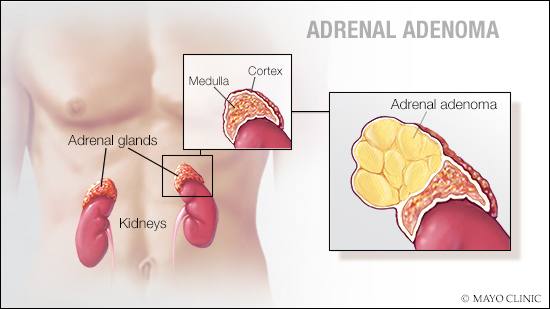-
Featured News
Mayo Clinic Q and A: Understanding adrenal adenoma

DEAR MAYO CLINIC: On a scan of my abdomen, an adenoma was found incidentally on one of my adrenal glands. What causes this? Should I be concerned? I am a 74-year-old woman. Although I am overweight, I'm in generally good health otherwise.
ANSWER: Adrenal adenomas are one of several types of nodules that develop on the adrenal glands. They are common, and they usually don't pose a health threat or require treatment. When adrenal adenomas are discovered, however, a thorough evaluation of their appearance and hormone production is necessary to confirm that the adenomas are not cancerous and they won't lead to other health problems.
Your body has two adrenal glands, one above each kidney. As part of the endocrine system, adrenal glands produce hormones that contribute to sexual development, and regulate metabolism, blood pressure, stress and other essential bodily functions. Each adrenal gland has two parts: the outer cortex and the inner medulla. Adrenal adenomas develop in the cortex.
It's not clear what causes adrenal adenomas to form. They tend to be more common in older adults and people who are obese, as well as in those who have diabetes or high blood pressure. As in your case, adrenal adenomas often are found incidentally on abdominal imaging exams performed for another reason. Because of that, sometimes they are nicknamed adrenal "incidentalomas."
When imaging reveals a nodule in an adrenal gland, several steps are taken to confirm whether it's a noncancerous, or benign, adenoma. The images are evaluated closely to examine the nodule's appearance. Factors such as how bright the nodule appears on the imaging, its shape and size, as well as the presence of other distinguishing features, can differentiate a benign adrenal adenoma from a mass that may be cancer. If a nodule looks like it might be cancer, then additional imaging or other follow-up tests may be recommended.
Benign adenomas sometimes can cause excess production of certain adrenal hormones. Normally, the adrenal glands secrete various hormones, such as cortisol, a steroid hormone that can affect blood pressure, blood sugar and weight changes; aldosterone, a steroid hormone that affects blood pressure and salt concentration; and adrenaline, another hormone that affects blood pressure. When an adrenal adenoma is found, a series of blood, urine or salivary tests are performed to assess hormone production.
If the testing shows an overproduction of hormones, the care team may recommend removal of the affected adrenal gland, although the necessity of this surgery varies. In cases when a patient with an adrenal adenoma also is experiencing symptoms, or if his or her medical history points to the possibility of another underlying medical condition, then more testing would be performed to further evaluate the situation before surgery or another treatment is recommended.
When adrenal gland hormonal production is normal and evaluation of the imaging shows no signs of a nodule being anything other than a benign adrenal adenoma, then no treatment or further testing typically is necessary at that time. If that's the situation for you, your health care provider may recommend a follow-up appointment in six months to two years to repeat the imaging and recheck hormone levels. If any significant changes are noted, then treatment may be appropriate. — Dr. Sarika Rao, Endocrinology, Mayo Clinic, Jacksonville, Florida







